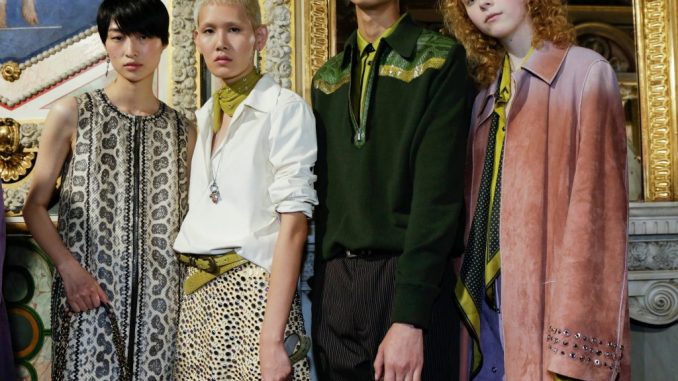
MILAN — It was 9:30 a.m. on Saturday, the Bottega Veneta show was about to start, and François-Henri Pinault, chief executive of Kering, the French conglomerate that owns the Italian brand, was het up.
Were the models late? Had some clothes not arrived? Did he — oops — not like what he saw?
Nope. His morning had been ruined because of the news that the Trump administration was changing the federal government’s policy on sexual assault on campus, potentially allowing colleges to raise the standard of proof required, a decision widely seen as altering the balance of power toward the colleges and away from the victims.

CreditGio Staiano/Nowfashion
Kering has a women’s foundation that had done a lot of work on the issue, and he couldn’t believe what he had read. He was wondering if there was a way they could protest the decision. Between that and the Mexico City earthquake (his wife, Salma Hayek, is Mexican) there were things on his mind besides fashion.
At least until the show began. Then the sporty 1970s shapes — straight skirts and boxy jackets and belted trench coats and T-shirt gowns — in color field combinations of chartreuse, lilac and dusty rose, teal and olive green and dark gray, adorned with metal grommets and glinting mirrors so the utilitarian was transformed into the decorative, demanded a certain attention.
A few Pocahontas fringed dresses aside, this was a smart (in every sense of the word) proposal for how to navigate a world where attention is elsewhere; a sophisticated reminder that between no frills and fantasy, aesthetic invention can still be found. The priorities were right.

In the bowels of a decrepit theater, Antonio Marras threw a Weimar-like cabaret for the end of the world, complete with a woman soaring overhead on a swing, and piles of distressed velvets, beading, fringe, florals and regimental stripes. Also a brass marching band. A model at Salvatore Ferragamo walked in one direction in a fringed flapper dress and almost bumped into a model walking the other way in a cherry red bathing suit and matching sheer anorak. A hand-painted python halter dress and a watercolor velvet gown with teeny straps passed like ships in the night. It wasn’t clear where to look, or what was the point. (Well, shoes.)

CreditRegis Colin Berthelier/Nowfashion
“It’s just clothes” is the usual refrain; there isn’t any big point! And there’s nothing wrong with just clothes — except that the outside world has so much more urgency than what has been on the runway, the connection between the two seems increasingly frayed.
Angela Missoni, celebrating her 20th anniversary as the family brand’s creative director, decided to do it with a combined men’s and women’s show dedicated largely to … party duds. Hot pants and sheer metallic maxi dresses, disco leggings and matching crop tops (the men mostly got to wear pants, lucky them), all in the signature fine-gauge knit. It was pretty but ultimately the fabrics were awfully thin. So was the idea.

Milan has never really been an intellectual fashion city; leave that to the deconstructionists and conceptualists of Paris and London. It’s more about the immediate gratification of extraordinary fabric and high-voltage cleavage. But at the very least such clothes should ease your way in the world; give you a sense of possibility, or strength, or protection as required by moment. They don’t have to espouse philosophy. They do have to serve a purpose. If only to create visual coherence in a chaotic time.

See, for example, Marni, where the designer Francesco Risso, in a much-improved sophomore outing, tackled the subject full-on, embracing plaid, 1950s sofa florals, diadem pearls, canvas and leather (also some David Salle nudes), and then taming the mess in controlled combinations of corsetry, voluminous skirts, clown pants and cocktail frocks. Or Etro, where for the first time Veronica Etro, the women’s wear designer, and her older brother Kean, who handles the men’s wear, worked together on a joint collection.
Instead of a recipe for confusion, it brought a balance often missing in the brand. The combination of his tailoring and flower-children-on-the-silk-road (they both have a genetic love of paisley and maharajah-meant materials) created a tension that was apropos.

Which was broken, finally, at Versace, where in a Tribute collection to her brother, Gianni, Donatella Versace revived the wild prints of the 1990s in a riot of thigh-high jeweled boots and catsuits and schoolgirl pleated skirts and sharp-shouldered jackets.
At the end of the show, the curtain came up on a tableau of supermodels — Carla, Claudia, Helena, Naomi, Cindy — in gold chain mail goddess gowns, who proceeded to strut so convincingly down the runway they reduced the jaded fashion audience to gibbering fanbots. Those legs! That hair! That elemental force of femininity!
By

